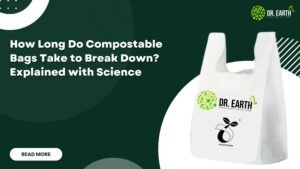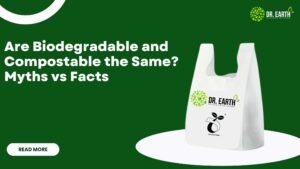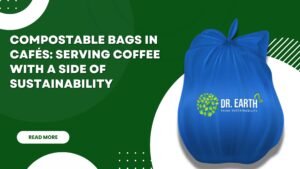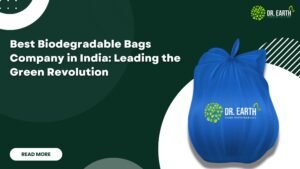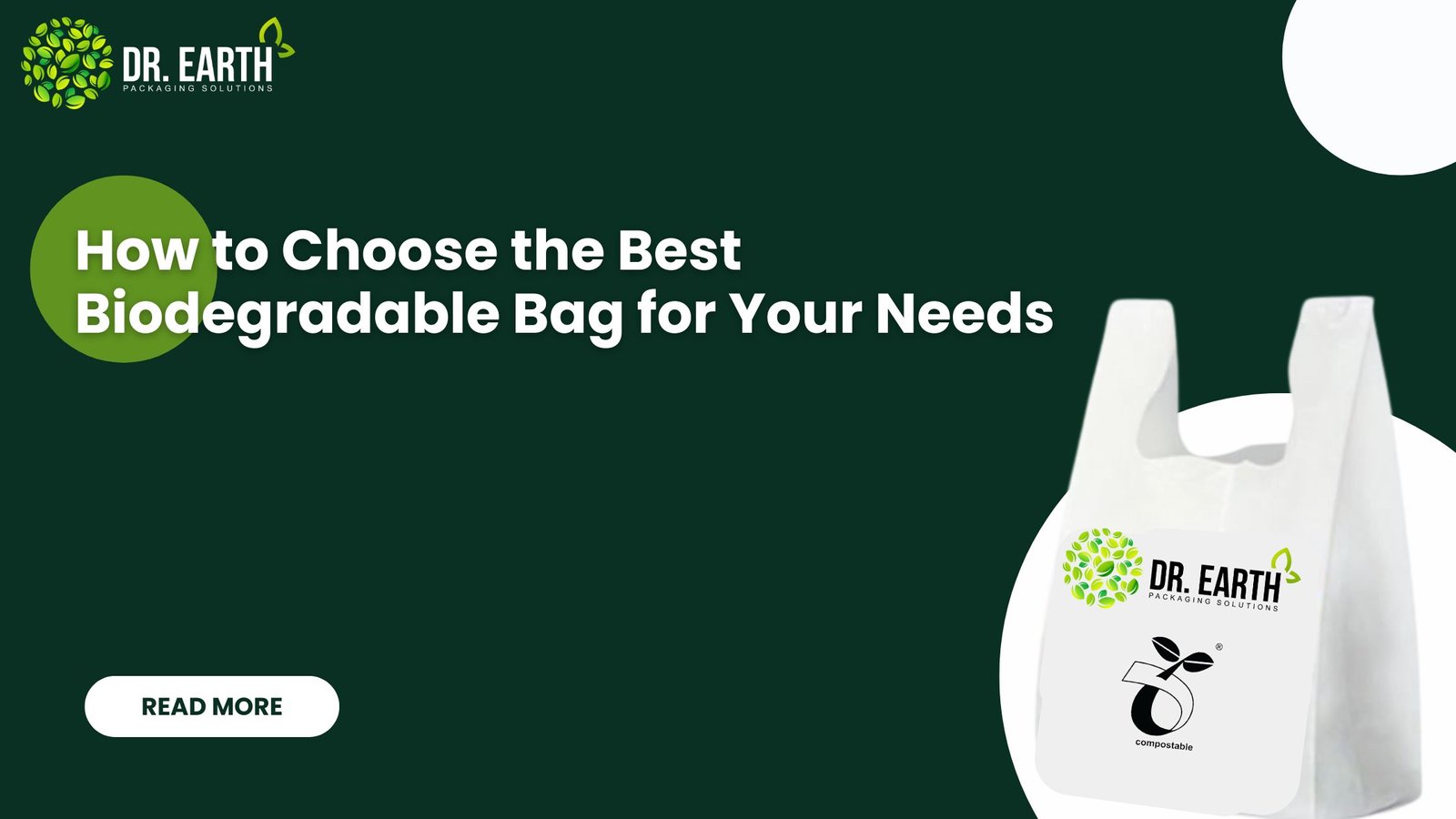
People are getting more attracted towards biodegradable and compostable alternatives of plastic bags, with increasing environmental concerns. Biodegradable bags are more sustainable as they decompose naturally and do not contribute to the long-term waste. But not all biodegradable bags are equal; hence, the purpose of comparison is to know the different types of materials available—biodegradable, compostable, and other types of eco-friendly materials—and different types of biodegradable bags.
In this blog, we shall look at how to choose the perfect bag for your needs whether you are shopping bags or waste disposal bags, with considerations around material, strength, functionality, and environmental impact. Dr. Earth compostable bags are the ideal solution for consumers searching for a positive impact on the world without sacrificing performance or convenience.
Understanding Biodegradable and Compostable Bags
First, before we find the best biodegradable bag, let us first understand the proper term and difference between the terms ‘biodegradable’ and ‘compostable’, as these are widely use interchangeably but mean fundamentally different things.
- Biodegradable Bags: Biodegradable bags turn into natural elements such as water, carbon dioxide, and biomass over time when they are deposite in the open environment. One should note that not all biodegradable bags degrade to nature. They leave a significant amount of microplastics, especially when they are made from petroleum-base material.
- Compostable Bags: This is a kind of biodegradable bag, but these have to face strict decomposition in terms of necessity. They are submitted to the appropriate environment, such as industrial composting facilities or home composting bins, where the compostable bags decompose within a specified time into non-toxic natural elements. In the composting environment, compostable bags are expected to break down into organic matter that enriches the soil. The bags of Dr. Earth are made from renewable and biodegradable plant-based resources and therefore must be a better choice for the environment.
Factors to Consider When Choosing the Best Biodegradable Bag
When you pick the best biodegradable bag for your needs, there are several factors to consider to ensure it fulfills your requirements. The main considerations are highlighted in the following sections, while Dr. Earth‘s range of biodegradable bags provides eco-conscious solutions for every occasion:
1. Material Composition
The most important thing about a biodegradable bag is the material being used. Different materials provide different strengths, biodegradation, and environmental aspects. Among some of the common biodegradable materials used in the making of bags include
- Cornstarch: Cornstarch-based compostable bags are the most widely used. They break down fast in composting conditions and are always made from renewable, plant-based resources.
- PLA (Polylactic Acid): PLA bags are made from fermented plant starch, either corn. PLA bags can be composted in industrial composting conditions and break down into biologically active elements. They are suitable for lightweight products and food packaging, but not as strong as others.
- PBAT (Polybutylene Adipate Terephthalate): polybutylene adipate terephthalate: biodegradable plastic and also a product derived from fossils. Its life cycle is, however, relatively faster compared to other traditional plastics. Often, it is blended with the former in order to produce a relatively more robust bag. Most of the bags are used for waste management and other applications where strength comes into the picture.
- Paper-Based Bags: Paper bags, although not biodegradable in strict sense, are far more environment-friendly than plastic bags. They decompose fast, though not excellent for heavy-duty use and likely to be of higher carbon in production.
- Sugarcane and Other Plant Fibers: Sugarcane or other plant fibers, like jute or hemp, is another compostable and biodegradable bag. It is sturdy, renewable, and naturally breaks down, hence ideal for the ecologically conscious customer.
2. Strength and Durability
Another important choice when selecting a biodegradable bag is strength. Depending upon the purpose for which a biodegradable bag is desire, ensure that the bag’s strength will keep things together so as not to break or rip open with contents.
- This is especially true with the durable but “eco-friendly” grocery compostable bag from Dr. Earth.
- If you are using it for waste disposal, you may need a thickness that can hold organic waste without tearing. Good choices for this are compostable trash bags, made from PBAT or other very resistant biodegradable materials.
- If you need a lightweight bag for smaller items, then a PLA or paper-based bag would be enough.
Always check the bag’s specifications, including weight limits and recommendations, to ensure that it meets your strength requirements.
3. Intended Use
Consider how you will use the biodegradable bag in your selection. Biodegradable bags are offer for different uses, such as grocery shopping, waste disposal, food storage, or even packaging. Let’s look at some common uses:
- Grocery Bags: A bag designed by Dr. Earth made of cornstarch or PLA—biodegradable—which provides the generic function of grocery carrying ability—can carry typical loads and break down naturally within composting environments without having plastic bags.
- Waste Disposal Bags, which are typically made of PBAT or a formulation of other biodegradable materials, are meant to hold organic waste. Holding organic waste and the contents are clearly two different things, as Dr. Earth compostable waste bags can break down at approximately the same rate as the organic waste they hold.
- Food Storage Bags: PLA bags are stored in food since they are biodegradable and secure, non-toxic ways to keep edibles fresh. Dr. Earth’s food storage bags do not contain lead, chlorine, or BPA.
- Packaging: Some biodegradable bags are made for packaging items.
4. Decomposition Time
Biodegradable bags do not degrade at the same rate. If you desire a degradable bag that breaks down fast and easily, make sure you consider the decomposition time. Compostable bags break down much faster than biodegradable bags in most conditions, hence useful for waste diminishment over time periods.
- Compostable bags: The time will depend on several variables, such as temperature, humidity, and how the compost is done.
- Biodegradable bags: These bags break down over time, but much more slowly than the compostable ones. The biodegradable bags might even leave microplastics or other residues that will be devastating to the environment after decomposing.
5. Certifications and Standards
To be sure that what you are buying is truly biodegradable or compostable, you must look for certifications and industry standards. These labels indicate that the product has been test to meet specific environmental criteria.
- Compostable Certification (e.g., ASTM D6400 or EN 13432): This means the bags will compost and break down in industrial composting facilities or home compost bins. Compostable certification for Dr. Earth ensures they are up to such strict standards.
- Biodegradable Certification: You will look for biodegradable bags carrying a certification like OK Compost, which would mean the bag would break down in certain conditions.
How to Make the Final Choice
We have covered the significant aspects of choosing biodegradable bags above. Now, given below is a step-by-step guideline to finally select a suitable one:
- For waste disposal, choose compostable bin bags with PBAT or another strong biodegradable material. These will safely hold organic waste and naturally degrade in composting conditions.
- For food storage: PLA bags are recommend for food product storage like fruits, vegetables, etc., since they are biodegradable and food-contact safe.
- For heavy-duty use: It is much more likely that PBAT-based bags will be more probable for durable purposes while still being biodegradable for heavier applications.
Dr. Earth has its line of biodegradable compostable bags, the best for an environmentally conscious customer who, by selecting them, is making the sustainable difference. You make a conscious decision when you choose Dr. Earth eco-friendly products to reduce your carbon footprint by contributing to a cleaner, greener planet.
Conclusion
A biodegradable bag can minimize your environmental footprint and lead towards a more sustainable future. Whether you are shopping for groceries, managing waste, or storing food, bags offer you an eco-friendly alternative to traditional plastic, which helps make a positive impact on the planet.
Biodegradable and compostable bags from Dr. Earth are craft with you in mind towards a greener, plastic-free future, supporting companies like Dr. Earth that lessen pollution through plastics and encourage sustainable products.
FAQs
Q- 1. What’s the difference between biodegradable and compostable bags?
Ans- Compostable bags decompose within a specific duration of time, like 90 days, within the bounds of the environment of compost. Bag Dr. Earth, compostable.
Q- 2. Are Dr. Earth’s bags safe for food?
Ans- Yes, the bags of Dr. Earth are from non-toxic materials like cornstarch and PLA, so safe for food storage.
Q- 3. How long do compostable bags take to break down?
Ans- The compostable bags of Dr. Earth usually break down within 3 to 6 months in a composting environment.
Q- 4. Can I use biodegradable bags for trash?
Ans- Yes, the compostable bags of Dr. Earth are ideal to be use with organic waste and can be composted.
Share:
Related Posts
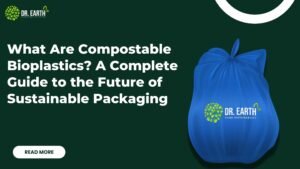
What Are Compostable Bioplastics? A Complete Guide to the Future of Sustainable Packaging
Read More »Send Us A Message
Related Posts




